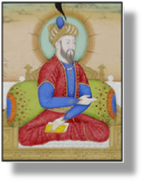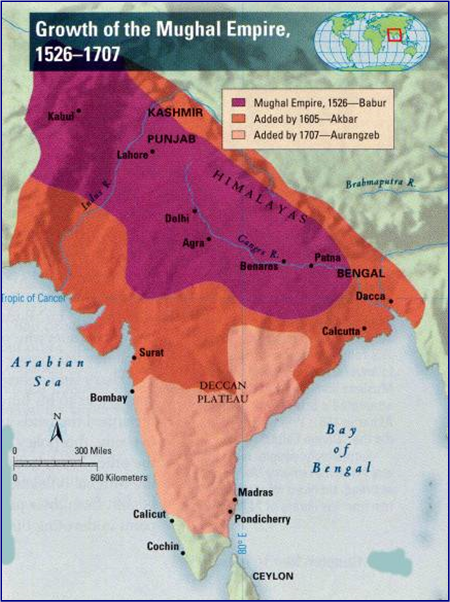


BABUR, FIRST MUGHAL LEADER OF INDIA
1526 -
xxxxxAs we have seen (1402 H4), on the death of the highly successful Turkoman Mongol leader Tamerlane in 1405, his vast lands were divided up. Out of the inevitable struggle for power emerged his great grandson Babur (1483-
Including:
The Battle
of Panipat

xxxxxAs we have seen,  by the year of his death in 1405, the Turkoman Mongol leader Tamerlane had conquered vast areas of the Middle East and southern Asia. His final achievement was a decisive victory over the Ottoman leader Bayazid at the Battle of Ankara in 1402 (H4). This slowed down the Turkish advance and thus gave a few years of extra life to the ailing Byzantine Empire. Having received submission from both the Sultan of Egypt and the Byzantine Emperor, Tamerlane returned to Samarkand and died while on his way to conquer China!
by the year of his death in 1405, the Turkoman Mongol leader Tamerlane had conquered vast areas of the Middle East and southern Asia. His final achievement was a decisive victory over the Ottoman leader Bayazid at the Battle of Ankara in 1402 (H4). This slowed down the Turkish advance and thus gave a few years of extra life to the ailing Byzantine Empire. Having received submission from both the Sultan of Egypt and the Byzantine Emperor, Tamerlane returned to Samarkand and died while on his way to conquer China!
xxxxxOn his death, his lands were divided among his sons and grandsons and this led to the inevitable internal feuds. His dynasty, the Timurids, managed to rule Transoxania and parts of Iran as late as the early sixteenth century where they became noted for their patronage of Persian art and Turkish literature. Samarkand developed into a well-
 xxxxxBut of all Tamerlane's descendants, it was his great-
xxxxxBut of all Tamerlane's descendants, it was his great-
The dynasty got off to a shaky start, with his son, Humayun, forced into exile for some fourteen years. As we shall see (1556 M1), it was left to Babur's grandson, Akbar the Great, the third Mughal emperor, to establish the dynasty firmly on the subcontinent of India. It was not until the reign of the English king, Charles II (1660-
xxxxxIncidentally, apart from being an able soldier, Babur was, for the age he lived in, a man of rare compassion. Cultured, witty, and a lover of natural beauty, he also gained a reputation for his poetry and autobiographical notes, translated into English in 1922 with the title The Memoirs of Babur.



Acknowledgements
Babur: detail of watercolour from Babur Enthroned, c1720, by Indian artist Khair Ullah (active 18th century) – San Diego Museum of Art, California. Map (India): licensed under Creative Commons-
H8-